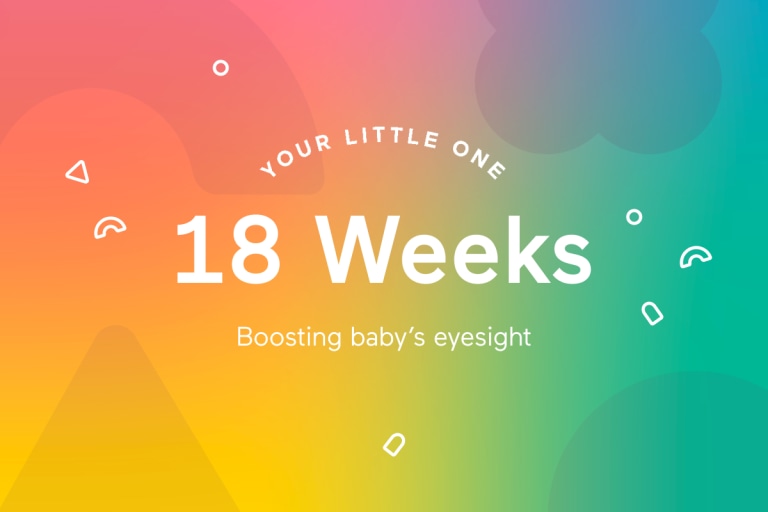
Your 18-Week-Old Baby
Visual milestones, treating Diastasis recti and tips on what to do if your baby falls.

By Babylist Staff
Milestone: Depth Perception
As you’ve probably noticed, your baby’s eyesight is continually developing. (At birth, they could barely see your face and now they can’t stop smiling at it!)
The ability to focus, move eyes accurately and even use them together are all important milestones babies experience as they explore their exciting new world.
According to the American Optometric Association, babies aren’t born with depth perception (the ability to judge if objects are nearer or farther away than other objects). But between five and eight months, the eyes join forces to form a three-dimensional view and begin to see in depth. This helps babies better identify edges (like the stairs!) and figure out which object is closer.
However, you still need to keep a really close watch on your busy kiddo, especially if you have a roller. So, if you need to go to the bathroom or retrieve your diaper delivery, put your tot safely in the crib or buckled into a baby seat.
Tips to Boost Visual Development
- Have playtime with the mobile in your baby’s crib
- Place toys just out of reach for your baby to work toward grabbing
- Give your baby various objects to hold like blocks, board books, teethers and rattles
- Move your baby’s hands through different motions when you’re singing songs like patty cake or playing peek-a-boo
Try This: Shake, Rattle and Roll
Rattles have been around for a long time, and for good reason. These simple toys delight babies’ budding senses as they get the hang of cause and effect, plus they help strengthen hand-eye coordination. From wearable rattles to wooden classics, these are Babylist parents’ favorite rattles.
What Should You Do If Your Baby Falls?
No matter how careful, doting and attentive you are, falls can happen. One of the most common causes at this age is rolling off of something, like furniture.
Adrienne Dreyfuss, MD, FAAP, recommends going through this checklist to provide your doctor with important information if your baby falls:
- How far did the baby fall?
- What surface did they fall on (cement, hardwood, carpet)?
- What part of the body did they hit? (Usually the head hits first since it’s the heaviest part of the body.)
- Is there a pink spot, bruise, welt, swelling, bleeding?
- Did the baby cry right away?
- Was the baby able to be soothed?
- Was there any vomiting?
- Have they nursed or drank since and kept it down?
- Are all arms and legs moving normally?
Dr. Dreyfuss explains, “If the baby cried right away, had no loss of consciousness, drank or nursed with no vomiting, was appropriately soothed, is moving all arms and legs, and is acting normal, then it’s OK to call your pediatrician for advice and/or monitor the baby closely. We no longer recommend waking babies periodically to monitor because they will likely be cranky if woken, so you won’t get a good evaluation. If anything mentioned here is abnormal, take the baby to the closest ER (a pediatric ER is preferred) for evaluation.”
There’s no need to panic if your baby has a bruise or swelling, as long as they’re otherwise acting like their usual self. Put cool compresses on the skin, but make sure the ice/cool pack is wrapped in a towel. While you can give your baby Infants’ Tylenol for pain management, ibuprofen (Motrin/Advil) is not safe until six months of age. If there’s an open wound, and it’s hard to stop the bleeding, Dr. Dreyfuss recommends cleaning it well with water and taking your baby to the pediatrician.
If your baby isn’t moving their arms and legs normally, then head to the ER (pediatric ER if possible) for evaluation. It’s always good to page the on-call pediatrician at your practice for advice too. But don’t wait for a response to head to the hospital.
Your Body: Dealing with Diastasis Recti
Diastasis recti is a common postpartum condition, but many women have never heard of it until they have it.
During pregnancy, your abs start to stretch and separate thanks to your growing uterus and hormonal changes. This happens without you even noticing, but sometimes the muscles remain separated by an abnormal distance after delivery. A telltale sign of Diastasis recti is when your belly still pooches out months after you gave birth, and it may cause lower back pain, constipation or urinary incontinence. You may actually be able to feel the gap in your abs when you lay flat on your back, contract your stomach muscles and gently press your fingers into the area around your belly button.
The best way to diagnose Diastasis recti is to see your doctor. They may refer you to a physical therapist who specializes in postpartum health for guidance on safely rebuilding your abdominal wall with the right exercises (crunches can actually worsen the condition!). In extreme cases, surgery is required.